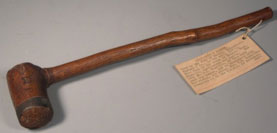An auctioneer’s hammer said to have been used in the Dunedin firm of McLandress, Hepburn and Co. is the subject of today’s story.
Alexander McLandress arrived in Dunedin in the early days of the gold rushes, trading briefly as A. McLandress and Co. before teaming up with William Hepburn to form McLandress, Hepburn and Co.
Alexander McLandress had latterly come from Australia, where in the late 1850s he had been the first chairman of the municipality of Maryborough in Victoria.
One Saturday in the autumn of 1865 Alexander, a lieutenant in the Otago Light Horse, set off to test-ride a horse he was considering purchasing. He rode up to Halfway Bush to watch a ploughing match. The horse did not meet with his approval so for the ride back he swapped it for a friend’s horse. Part of the way home the horse lost its footing and left Alexander McLandress lying unconscious on the road with a great gash on his forehead. At 2 a.m. the following morning 37-year-old Alexander McLandress was pronounced dead. His funeral on 8 May was conducted with military honours. A couple of days later his pregnant widow Louisa went into labour but the child was stillborn.
Another well-known and respected person associated with McLandress, Hepburn and Co. was cashier and accountant Robert ‘Snuffy’ Rutherford, who in 1877 became the first Mayor of Caversham. In 1870 friends at the auction room, who ‘Snuffy’ regularly supplied with pinches of snuff, presented him with a silver snuff box inscribed ‘To a regular snuffer, R. Rutherford, by the surrounding irregulars’. Following the death of co-founder William Hepburn in 1887, McLandress, Hepburn and Co. disappeared. The hammer, however, was passed down through succeeding firms James A. Park and Co. and Park, Reynolds and Co., before being donated to the Museum in 1942.
By Peter Read, Curator, Toitū Otago Settlers Museum
